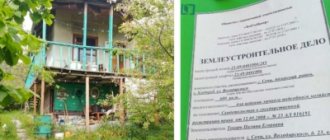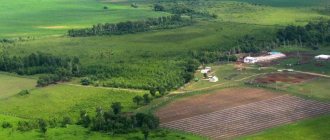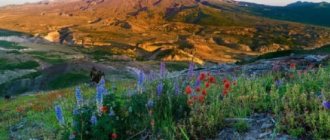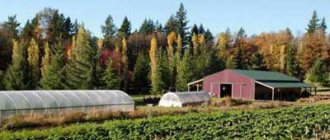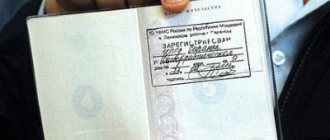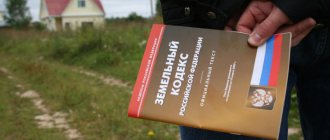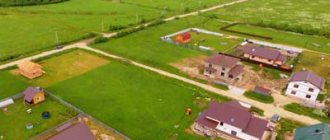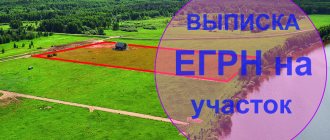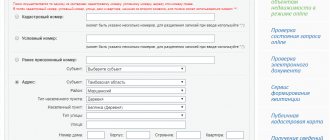A hectare of land for every Russian: the Far Eastern Hectare and My Hectare programs
Today in Russia there are two programs, the participants of which can receive land plots of 1 hectare or more in ownership.
The first program is a state one, it is called “Far Eastern Hectare”.
The second project is “My Hectare”, it started on August 1, 2021 with the support of the Union of Gardeners of Russia. The organizer of this project is , who has been working in the land segment for more than 10 years.
There are currently no other serious projects under which Russians can obtain land on favorable terms on the territory of the Russian Federation.
“Far Eastern Hectare” and “My Hectare” have their own characteristics and differences, which we will dwell on in more detail.
Far Eastern Hectare Program
The Far Eastern Hectare project gives every resident of Russia the right to receive a free plot of land with an area of no more than 1 hectare. A family of 3 people, accordingly, can count on 3 hectares - these lands can be combined.
Land is allocated in the regions of the Far East; it can be used for the construction of a private house, for business activities or for organizing a farm.
The state allocates plots of land for free use for a period of 5 years - in the 6th year it is already possible to register ownership of them, but only subject to the development of the land and its use for its intended purpose.
The Far East and Siberia have unfavorable conditions for agriculture: the climate is cold, the soil freezes deeply in the cold season, there are few sunny days a year, but there is often strong gusty wind.
Not all areas where land is allocated have good transport links and communications necessary for life or business. In particular, the lack of running water in villages seriously complicates the watering of crops.
Project "My Hectare"
The “My Hectare” project looks more attractive against the backdrop of the “Far Eastern Hectare”. Its participants can receive a plot of 1 hectare or more in the Moscow region (Novorizhskoe Highway, Leningradskoe Highway and other popular destinations), in the Central regions of the country (Tverskaya, Kaluga, Vladimirskaya and other regions).
The land can be used for garden and country house construction, farming or agricultural production.
Plots under this program are conditionally free - from 50 thousand rubles per 1 hectare. This is significantly lower than current market prices. At the same time, Russians immediately receive ownership of them, which is confirmed by relevant documents of the established form.
The central regions of the country have favorable climatic conditions for crop and livestock production. They are located in a zone of temperate continental climate with a clearly defined seasonality, the soils are predominantly sandy loam, and the soil freezes slightly in the cold season.
The only disadvantage of the “My Hectare” program is that the number of plots is limited. Up-to-date information about their availability can be found on the website of the organizer of the “Big Land” campaign.
About the project “My Hectare”
Published:06/04/2021
A. Golubev - 12 hours and 07 minutes, Alexey Golubev is at the microphone, hello. The topic of our broadcast today is “New format in the land market.” In our studio, Inna Demkina, Deputy General Director. Inna, good afternoon.
I. Demkina - Good afternoon.
A. Golubev - And Igor Kalinin, development director of the “My Hectare” project. Igor, hello.
I. Kalinin - Hello.
A. Golubev - Colleagues, please tell us, today we can simply open the Internet and see there literally hundreds of thousands of advertisements for the sale of land plots of various sizes. Help us navigate this choice, variety, how to find the area we need, and most importantly, not run into any intruders.
I. Demkina - Of course, our market is so vast, it has a huge number of offers. But the most important thing is to decide what kind of site you want, where it will be located in terms of distance, remoteness, and what category it will be. After this, you need to decide on the company with which you will interact.
For our part, we recommend large companies that already have a name on the market and have been selling land for a long time. After contacting the company, you will need to clarify whether this company is the owner of the site and whether it will provide you with all the documents confirming ownership. After that, familiarize yourself with these documents. Well, I would probably like to say on my own behalf, since I am a lawyer, that without the opinion of an expert, a specialist, it is better not to enter into a transaction. Since entering into an agreement, and only after that finding out that there is something wrong with the land, with the right of ownership, there are restrictions, encumbrances - this is extremely unpleasant and a loss of money. Therefore, of course, I think that expert opinion is the most important thing.
A. Golubev - Tell me, please... Probably a question for you, Igor. Tell us about the “My Hectare” project. I just know that we hear about such things as the “Far Eastern Hectare”, “Leningrad Hectare” programs, and something like that. There is even an “Arctic Hectare”. Does “My Hectare” have anything to do with all these programs?
I. Kalinin - Yes, that’s right. Well, let’s figure out what the “My Hectare” project, the “Far Eastern Hectare” program and other government programs have in common and what are the differences. Let's start with the fact that in July 2013, the Russian government approved the Federal Target Program for the Sustainable Development of Rural Territories. This is a Federal program, a state one. Since that time, government agencies and private companies began to develop plans on how to apply this program and build their activities there. The first real steps within this program took place in 2021. Moreover, government programs (“Far Eastern Hectare”) and programs from private business (“My Hectare”) arose almost simultaneously. “Far Eastern Hectare” arose in June 2016, this is a program initiated by Dmitry Anatolyevich Medvedev, and it is very popular, that is, everyone knows about it.
The “My Hectare” program-project was initiated by the group, which is one of the largest wholesalers in the country real estate market in the Central Federal District. So, what they have in common is that these programs work within the framework of one targeted state program. Its goal is to involve lands that have fallen out of agricultural use and develop the territory in correspondingly rural areas.
What is the difference? Firstly, even the very name “Far Eastern Hectare” is a program that allows residents to take a fairly large plot of land for temporary use in the Far East. That is, we initially provided that lands that could be taken not for temporary use, but that they could be purchased into private ownership, so that these lands were located in the Central Federal District. First of all, we are talking about Central Russia, the Moscow region, the Tver region, and the territories adjacent to them. The third, very important difference between the “My Hectare” project and government projects is that we have a service company that helps develop and develop the territory in a collective format. That is, we provide services for infrastructure development and land development, in particular for each owner.
A. Golubev - You have already partially touched upon the topic of the location of these areas. I understood correctly that a hectare can be purchased even in the Moscow region.
I. Demkina - Yes, of course, at the moment our company has 50 projects that we have already implemented. All projects can be viewed in detail on the My Hectare , where you will also see their location. Initially, in the history of our company, our development takes place in the north-west of the Moscow region, this is Novorizhskoye and Leningradskoye highway. The nearest land settlement is “Estate in Zavidovo”, approximately 100 kilometers from the Moscow Ring Road, and “Estate in the Moscow Region” in the Novorizhskoe direction is also approximately 100-110 kilometers. We also have a more distant direction, this is along the Leningradskoye Highway, Vyshny Volochek, Bologoye. If you know Bologoe, this is a city that is located between St. Petersburg and Moscow, respectively, both citizens living in St. Petersburg and in Moscow can choose the most convenient plot of land for themselves based on location. Well, in fact, we have requests from all over Russia, because after all, there is good ecology here, and we select sites near populated areas, water bodies, with convenient transport accessibility, all year round. And of course, such an assortment gives everyone the opportunity to choose the site that is right for them.
A. Golubev - Well, often the most delicious pieces, as they say, are sorted out first. Is it possible to buy a plot of land in some picturesque, truly beautiful places, along the banks of rivers, perhaps?
I. Kalinin - I agree with you that the most beautiful places, and the best ones, are always purchased first. Firstly, I want to say that we locate all our villages in the north-west of Moscow. If you and I open the ecology map of the Moscow region, we will see that the north-west is the cleanest ecological place. There are understandable reasons for this, firstly, due to the wind rose, the winds blow there from north to south, so everything blows out. Secondly, the absence of hazardous industries in the north-west, and most importantly, the presence of vast territories that are occupied by forests, both coniferous and deciduous, which means the presence of a large number of water bodies.
All our villages are located next to fairly large bodies of water. That is, such as, for example, the Moscow Sea, the Vazuz reservoir, this is a facility of the Mosvodokanal, that is, this is drinking water, the purest. Vyshnevolotsk reservoir, near the historical city of Russian Venice. Mstinskoye Reservoir, lakes such as Lake Pierce, Lake Prince. On the banks of the Volga River, and we are talking specifically about the sources of the Volga, where it originates, in the Selizharovo region, and then flows through Rzhev, through the Upsovsky district, and the Staritsa district. Rivers such as Osuga, Tvertsa, Kosha, Derzha, and so on. Fortunately, we have enough beautiful people in our country.
In general, we have territories that are 1/6 of the landmass of the entire planet, so there are many picturesque places, they are there for everyone, and we choose exactly those of our land assets that are famous for these beauties. And the North-Western direction, and the Moscow region, and the Tver region. I think you know that Igor Mikhailovich Rudenya, who has been serving as governor of the Tver region since 2021, one of his goals is the development of the region, the development of the tourist destination of the Tver region. He copes with this task perfectly, and the “My Hectare” project very succinctly falls within the framework of the development of the tourist destination of the north-west, and it is our common task, both the state and private business, to keep up with the times, to develop those territories that really deserve attention.
A. Golubev - I go to your website My Hectare , and there is a huge map with a huge number of plots for sale. Are these all actual lands? Which ones can you buy?
I. Demkina - Of course, these are current proposals, and on our website we have collected various proposals for any person’s request. It’s probably worth saying first and foremost that approximately 65% of our requests go to the construction of garden and country houses, and for the development of personal subsidiary plots. Next come requests for the construction of an individual residential building for year-round use. Now, probably, this development of peasant farming is gaining quite a lot of popularity; many people are applying for the possibility of building a base for raising livestock and vegetable growing. This is very popular at the moment, everyone wants to live in an environmentally friendly environment and eat good food. Investment projects for camping, glamping, and holiday homes are also gaining popularity. And on our website we have categories that make it possible to build such buildings and do business. Additionally, we provide an opportunity for investment, well, I think that a little later we will tell you in more detail how to invest in land and how profitable it is.
A. Golubev - I have a question, you say, you can buy it as a summer cottage. But why a whole hectare, that’s a lot, that’s right, that’s 100 acres.
I. Kalinin - Yes.
A. Golubev - We are used to six hundred square meters, we usually have a dacha, but here we have 100.
I. Kalinin - That’s right, you know, that is, just the “My Hectare” project, it breaks the stereotypes of thinking that there is not enough land. We really have a fairly large territory, but at the same time, for certain reasons, we are used to living within 5-6 or 10 acres, cottage villages, and dacha non-profit partnerships. I can tell you, based on statistics, on average they buy from us not one hectare, but two hectares. This is the average purchase statistic. Why? Firstly, in order not to have to expand in the future, not to buy land from your neighbors, or to rent this land so that you can expand. Or from the point of view of resale of this site, for the future. From my personal experience I can say the following: a hectare is actually not enough. When you start to develop the territory, the hectare ends quite quickly. Nobody says that the entire hectare needs to be planted with herbs and plowed. In our family there is such a small estate, a country residence, as you can call it, on the shore of the Rybinsk Reservoir. The area of the site is about 2.5 hectares. A hectare is quite a wide opportunity: not only to build a house, there is a bathhouse, a garage, and that’s it. You can place a greenhouse there, plant gardens, dig a pond, build a tennis court and a bathhouse. For example, we have two ponds, one for swimming, the second for technical needs. There is simply a recreation area where in the evenings we sit by the fire and barbecue. This area borders the forest. That is, it is not necessary to fence the entire territory, it can be fenced, yes, the part where you live, where the residential building is located, and the remaining territory is just adjacent territory, but is in your private property. And believe me, it is a great happiness to have land, to be an owner. This is the feeling when you walk along your land, touching the trees that grow on your site, it’s great.
A. Golubev - In general, the dream of a post-Covid person who survived quarantine, yes, of course. Let me remind you that in our studio Inna Demkina, deputy. General Director, and Igor Kalinin, Development Director of the “My Hectare” project. I have a question about the status of these lands that can be purchased as private property. Is this a village, SNT? What kind of lands are these?
I. Demkina - A short legal note. Our lands are divided into categories and types of permitted use. The category is the basis, and the types are a more precise definition of what can be done on a specific plot of land. In our projects, we have provided for the possibility of having agricultural land with various types of permitted use: vegetable growing, cattle breeding, crop production, summer cottage construction, and also lands of settlements. In fact, they correspond to all the types that we see in the city. This is the construction of an individual residential building, the construction of a store, recreation areas, and a holiday home. And each client can, based on his request, select a specific plot that is necessary for the development that he still plans to do on it. If we talk about SNT, then after all, SNT is a form of organization of citizens on a certain land, in a certain village. For our villages, we also have such a format as a citizens’ organization. For agricultural land, this is a cooperative. An agricultural, consumer, production cooperative, where people gather together and collectively determine the fate of the further development of our village. For land in populated areas, this is a partnership of property owners. This is the same format for organizing citizens on the ground to determine the further development of the infrastructure of our villages, how life will proceed, how they will vote, and what they generally want to see in these villages.
A. Golubev - And we already remembered about the pandemic, we cannot help but say this. Now, due to restrictions, the demand for country houses has increased; everyone wants to buy land, or at least rent a house. Are you helping to somehow speed up this process with landscaping, landscaping, and building infrastructure so that people don’t live on some plowed field there for decades?
I. Kalinin - Of course. Well, firstly, it is worth noting that the pandemic, which began last year, has changed people’s psychology in many ways. There is an understandable reason for this: the introduction of quarantine, the closure of borders, and again the spread of the virus. And if you look at the statistics, our number of requests and the number of owners tripled last year compared to 2021. And if you look at the statistics now, in less than 4 months, our number of requests has increased significantly. That is, it is worth noting that our psychology has changed, and we will never be the same after the pandemic. Nowadays, in many ways, people are thinking about the fact that it is very important to have, in addition to an apartment, a plot of land to which you can leave a densely populated area, take a break from the noisy city, go to the forest to pick mushrooms and berries, and be able to introduce children to work and not to gadgets , tear them away from gadgets. You can take your parents out into nature, grow clean organic products, all this can be done on your own hectare. This time. Many even think about having at least a reserve base so that, if something happens, they can go to their territory and simply live there, and perhaps even so that the land can feed them.
Many of us remember the 90s, when, due to the fact that we had our own plots and everyone grew food, my family in particular, they lived thanks to this and had the opportunity to survive.
In terms of assistance, I have already mentioned that we have a service company, and initially, when we conceived the idea of the “My Hectare” project, we thought about the need to help develop the territory. Because the processes of collective development require an initiator, they require a general line so that there is someone who would lead and give people the opportunity to collectively develop the territory. Therefore, in 2021, we opened a service company whose goal is to unite people within one team, within one structure, and the opportunity to develop the territory together. For this, we have our own fleet of construction equipment and road construction departments. We make the roads ourselves, thereby minimizing road construction costs.
We have all the specialists who work in the office, these are engineers, architects, designers, planners, estimators, but most of the people work on the ground, in villages. The service company's staff currently exceeds 100 people. And most of them are builders, work crews, tractor drivers, bulldozer drivers, engineers who work on the ground, build roads, build power lines, install electrical networks, equip public places, checkpoints, and organize security. That is, they are doing everything to build the basic infrastructure of the village. And all services for the development of your territory, and for the development of your site, can be ordered from your personal account. Right now you can go to the website Moygektar.ru, and there will be a list of services and how much they cost. They cost a lot even below market value. This means absolutely all services for the development of your site and your territory.
A. Golubev - But having a hectare is, of course, good, but we are not the Rothschilds, as they say, especially since times now are not simple. Is it expensive to have your own land? Another whole hectare.
I. Demkina - You know, when we launched the “My Hectare” project in 2021, the first thing we started with was that we decided to ask our friends, relatives, and just people how much one hectare of land costs. And the answers were completely different, but probably less than 1 million, no one answered us. At that time, we launched our first village at a price of 50 thousand rubles per 1 hectare, many simply could not believe that such a price was possible.
At the moment, we already have 50 villages, and today the minimum cost of one hectare of land is 100 thousand rubles. Of course, we have enough offers, and probably the average price will be approximately 200, 300, 400 thousand rubles. There are areas of special zones, they are located near water bodies, this is the first coastline, and of course, there the price can already reach a million, two million. But in any case, all the proposals, they give each client the opportunity to choose a plot that will be affordable for him.
Additionally, our company has a format for providing unique installment terms; we talk to each client individually and decide in what format it would be convenient to pay for a given land plot. We are quite loyal and ready to meet our customers halfway, and we understand that everyone has different circumstances. Additionally, not so long ago, probably about a year ago, we added a 10% discount for large families. For those who have three or more children, we are ready to provide an additional discount; we would like people to develop on the earth, so that children grow up on the earth. And from ours, we have special conditions.
A. Golubev - I see. Igor, in general, is land as an investment instrument relevant today?
I. Kalinin - Of course. Moreover, many owners consider the “My Hectare” project, including as an investment project, not only for personal purposes. Well, I won’t even hide the fact that I myself, and many of my colleagues, by the way, invest as part of the team, buy land, and have the opportunity to make money later. And I think that this is absolutely normal. Many of us now think like investors, we are considering different growth points where we can invest funds. Moreover, in order to make it transparent and clear what capitalization is and what ways to earn money are, we have posted several working strategies directly on the My Hectare , you can go in, look at the strategies and understand the calculation and capitalization. How much can you invest, how long can you pay back, and get added value. I won’t delve into the numbers now, but if we compare, for example, with projects on new buildings, where the average capitalization reaches 25, 30, 35%... 35 is considered a fairly high figure, then within the framework of the “My Hectare” project, the average capitalization reaches 200-250 % on the horizon of a year and a half, if this is an area of intensive development, where we immediately begin to build the infrastructure of the village in a farcical manner. This means 2 years, 2.5 on average, is a zone of standard development.
Our villages are also divided into zones. Therefore, here is the “entrepreneur” strategy, which involves purchasing a plot at the start of sales, at a minimum cost of 100-200 thousand rubles, then investing funds in infrastructure development, on average 100-120 thousand rubles, over a horizon of 1-2 years, which means capitalization reaches there 200-250%.
A. Golubev - Literally the last question. I chose a site on the website, I need to go there, look, make a deal, how does this happen? We have literally 10 seconds.
I. Demkina - We have provided all the possibilities for remote transaction execution. We have aerial photography, video tours. You can choose this site yourself without going to the area. Further, we undertake all transaction support, from the moment of concluding the contract until the transfer of ownership. At the same time, we have provided such a format as submitting documents using an electronic digital signature and using a power of attorney. Therefore, you can delegate to us all powers to carry out this transaction.
A. Golubev - Thank you very much, we talked about a new format in the land market. With us were Inna Demkina, deputy. General Director, and Igor Kalinin, Development Director of the “My Hectare” project, goodbye.
I. Demkina - Goodbye.
Source – Radio Ekho Moskvy
Far Eastern hectare: how to get a hectare of land in the Far East through government services?
According to Rosreestr statistics, from February 1 to March 15, 2021, 17 thousand people have already received and documented land plots in the Far East, almost 70 thousand applications are under consideration.
There is huge interest in the program. As the deputy head of Rosreestr explained, since the launch of the first stage of the law, the project website has been visited by more than 3 million users.
Let us recall that the law came into force on May 2, 2021; from October 1 of the same year, residents of the Far Eastern region were able to take advantage of the priority right to receive land, and from February 1, 2017, residents of other regions of the autonomous okrugs of the Russian Federation.
To use the program, you must:
- 1. Register on the website https://www.gosuslugi.ru.
- 2. Using the login and password that were used for registration, enter the website https://nadalniyvostok.rf and select a plot of land there.
- 3. Form the boundaries of the land plot, and then submit an application for its provision.
- 4. The application is submitted directly on the website and is considered within 30 days.
As part of the program, a competition is held for the best idea for using the land. You can also view business plans there.
In some areas, the sites border on China (in particular, in the Primorsky Territory, Amur Region and the Jewish Autonomous Okrug). The lands provided under the program in Kamchatka, the Chukotka Autonomous Okrug and the Magadan Region are washed by the Pacific Ocean.
The state promises assistance and support to participants in the Far Eastern Hectare program. According to the law, with a total of 20 or more land plots, regional authorities must assist program participants in developing the necessary infrastructure for the development of territories. However, local budgets do not always have the necessary funds for these purposes.
Plots allocated under the Far Eastern Hectare program cannot be sold or leased - in this case, permission for their development will be revoked.
Land in action
At first, while the new law is being tested, land is provided only in the pilot territory. Each Far Eastern subject of the Federation has its own. In the Sakhalin region, the pilot was the Tymovsky district located in the central part of Sakhalin Island, which has a reputation as a local agricultural breadbasket. The first recipients of the land were local residents - they are well acquainted with the peculiarities of the region, and therefore can easily decide which plots they need.
It took Alexander Tyrtsev, an individual entrepreneur from the village of Tymovskoye, just a few minutes to get his hectare of land for the construction of a workshop for growing mushrooms. He came to the local center for the provision of state and municipal services, and with the help of an employee, he selected a previously chosen site near the village of Voskhod on the interactive map of the federal information system “To the Far East.” It immediately became clear that this territory was still free, there were no other applicants for it. Alexander wrote an application and the very next day received an agreement on the free use of the land - you can start working.
Tyrtsev has been growing oyster mushrooms for three years now and uses a former store as a farm. Sells from 300 to 400 kilograms of products per month. It is readily accepted by buyers in Tymovsky itself and in neighboring areas. Demand for products is growing, but increasing production is prevented by the lack of new space.
“I was already figuring out how to get land to build a workshop,” says the entrepreneur. — I contacted the municipal property management committee. They answered me: only through an auction. And then the law on the “Far Eastern hectare” came out. I didn’t delay, I immediately submitted an application and received the land the next day. I saved, in my opinion, 400-500 thousand rubles. It’s a lot of money.”
In the near future, Alexander is going to lay the foundation and erect the frame of the workshop building. He intends to grow two to four tons of oyster mushrooms and up to a ton of champignons per month. Then the products of the Tymov entrepreneur will appear on sale in other cities of Sakhalin. The farmer plans to build a greenhouse for strawberries.
Yuzhno-Sakhalinsk. View of the city from the top of Mount Bolshevik
Photo: Yuri Samolygo / TASS
Pensioner Antonina Potyreva and her husband Victor had their eye on a plot on the outskirts of the village of Voskresenovka for a long time. They have a private farm: 12 cows, a large plot of land occupied by potatoes. But the cows also need hay, so after consulting with their two sons, they decided to apply for four hectares. “We learned that you can get free land from a TV show,” says Antonina Potyreva. — I went to find out the details at the mayor's office. They told me everything in detail. The application for the land was submitted very quickly, no difficulties. Now we will have our own hayfield - the grass there is good and juicy.”
And the Shkalygin family from the small national village of Chir-Unvd plans to breed bulls and grow vegetables on the received five hectares of former collective farm land. “I have experience,” says Tatyana Shkalygina. — I grew up in the village. My parents always kept cows and had a vegetable garden. We have received the land, now we will look for money to develop our personal farming.”
Most often, land recipients plan to engage in agriculture. But there are other interesting projects. Entrepreneur Temur Vasin runs a dry cleaning business, but wants to develop another business. On two hectares of land on the territory of the disappeared village of Upper Armudan, he and his wife intend to open a recreation center. “This will be the first such enterprise in the northern and central part of Sakhalin,” he says. — Guest houses, sauna, hunting and fishing all year round. There are very beautiful places here. My wife and I have been nurturing this idea for three years now. But the problem was with the land. Therefore, when we found out that the plot could be obtained for free, and even without long delays, we were very happy. We are ready to begin construction immediately. Let's start with the restoration of the existing buildings that remain from the village. They will become the basis of our base.”
Program for a hectare of land “My hectare”: how to register a hectare of land in the Moscow region?
The “My Hectare” project, launched on August 1, 2021, involves the acquisition of land ownership in specially demarcated zones. The goal of the program is to make land accessible, first of all, to residents of the Central regions of Russia, to give them the opportunity to build a dacha and try their own hand at farming, without radically changing their image and place of residence.
To participate in the project you must:
- 1. Go to the program website https://poselok-pobeda.rf and fill out the electronic form.
- 2. A specialist from the organizing company will contact you and provide complete information on the project.
- 3. You can immediately select a site on the website and book it remotely. A reservation agreement is a document that defines a plot, its area, and fixes the cost and terms of the purchase and sale transaction.
- 4. After booking, the applicant signs the contract and pays the cost.
- 5. Lawyers of the company organizing the program submit documents to the registration service, and after registration, hand them over to the owner.
Legal support for buyers is an important part of the program, since services for registering land ownership are provided to its participants free of charge.
A noteworthy nuance: land plots can be purchased for yourself or as a gift to family members or other close people. Upon receipt of the documents, ownership rights are transferred to you, i.e. the ability to cultivate, improve land, as well as sell or lease it. There are no restrictions, as in the Far Eastern Hectare project.
No problem
Minister of Property and Land Relations of the Sakhalin Region Elena Gakh said that the total area of land that can be provided to citizens in the Tymovsky district exceeds 10 thousand hectares. “About a thousand hectares are agricultural land, the rest is forestry. In the first days after the law on the “Far Eastern hectare” came into force, we received more than 20 applications.” According to Elena Gakh, the number of applications is constantly growing: only on June 2, contracts were signed for the free provision of more than 20 hectares. “When a person approaches us with an application for the free provision of one hectare of land, we have two options for resolving the issue,” explains Nadezhda Mosevnina, head of the land relations department of the Tymovsky district administration. “If he is interested in a plot that has already been registered in the cadastral register, everything is very simple: we prepare an agreement, and the citizen receives the land.” According to her, a minimum of time is required for this - the very next working day a person holds in his hands a signed agreement for the free provision of land.
Types of Sakhalin
Photo: Asia File/Alamy Stock Photo/Diomedia
If a citizen applies for a plot that has not yet been registered in the cadastral register, the local government body checks whether there are grounds for refusal. If there are no problems, the municipality approves the layout of the land plot and applies to Rosreestr with an application for cadastral registration. Then comes the signing of the contract. In the second case, the procedure, according to Nadezhda Mosevnina, may take about a month.
Hectare of land: projects for Russians
Each project has its advantages. The Far Eastern Hectare project will be of greater interest to those who live beyond the Urals. Some will be attracted by the Siberian climate and the opportunity to grow taiga and Far Eastern plants. In particular, Siberian herbs are an ingredient for pharmaceutical cosmetics and medicines. Or maybe relatives and parents already live in that region, from whom you don’t want to go far. A hectare of land free of charge will be an opportunity for some to improve their living conditions, and for others to start a farming business and organize sales of products in remote areas of the country.
The “My Hectare” project is aimed at people who are more attracted to the Central region of Russia. The purchase of a hectare of land in this project can be regarded as an investment in improving living conditions for your family and as start-up capital for business development. The hectares are located in ecologically clean areas with good prospects. In many villages, work on organizing transport infrastructure and utilities is underway or has been completed. In addition, the topography and climate of Central Russia provides more opportunities not only for crop production, but also for livestock farms. The important factor remains that there is no need to move to a new place of residence. A significant advantage is the location of the land plots within a 1-3 hour drive from Moscow.

